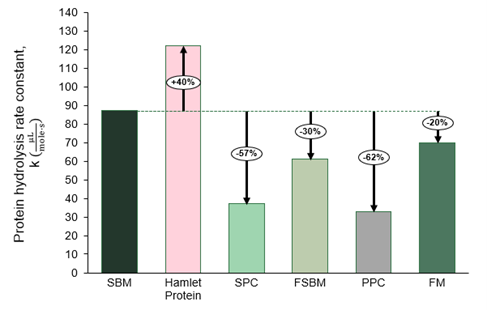Protein digestion kinetics in chickens: understanding the fate of dietary proteins
By Hamlet Protein
We have previously introduced the concept of Protein Digestion Kinetics, or just Protein Kinetics, and the importance of considering the digestion speed of protein from different protein sources when included in feed for young chickens and the effect it may have on performance and efficiency (Blanch & Rasmussen, 2023). Understanding this concept is part of our constant striving towards keeping up to speed with the latest knowledge within young animal nutrition.
In brief, we now know that Protein Kinetics is defined as the digestion of protein, the subsequent absorption of amino acids from the intestinal lumen and the transition of these amino acids across intestinal epithelial cells to enter the portal circulation (Liu and Selle, 2017). With this definition, not only the extent of nutrient digestion is considered, but also the rate (speed) and the site at which nutrients are digested and absorbed along the small intestine. Simply put, this means that the time from feed ingestion and subsequent amino acid release in blood determines how the amino acids are used; amino acids from protein sources that are rapidly digested are more likely to be deposited in tissues (muscles, organs) whereas slowly digested amino acids are mostly excreted as uric acid and ammonia (see figure 1). This new knowledge is the beginning of better understanding the fate of proteins from different sources within the animal and therefore the effect on performance.

Figure 1 Protein digestion processes of a fast (left) and a slow (right) protein source in different sites of the small intestine.
In young chickens, the foundation for long-term muscle development and growth is laid during the first 8 days of life: proliferation and differentiation of satellite cells in muscles, which are essential for normal muscle growth throughout life, reach the highest level during this period (Halevy, 2020) implying a high requirement for amino acids. Since its commonly known that young birds do not have a fully developed digestive capacity, the high requirement for protein during this early stage of their lives further emphasizes the importance of the speed of dietary protein hydrolysis.
The faster the protein, the greater is the proportion of resulting amino acids that are deposited in muscle tissue. Consequently, what has previously been considered high-quality protein may be challenged by this new concept as a high digestibility is no longer enough, although still important, but we also need the protein to be fast to ensure optimal utilization in the animal. If a protein source is highly digestible, but is slowly hydrolyzed, a greater proportion of amino acids transferred to blood is excreted and lost which leads to impaired chicken performance later in life. Therefore, fast protein kinetics is crucial for meat production efficiency.
In an ongoing project on this topic, products from Hamlet Protein were found to stand out in terms of digestion speed compared to other protein sources available in the market (figure 2).

Figure 2: Speed of protein degradation for various protein sources as measured by the hydrolysis constant k [µL/(mole*s); µL=microliter NaOH needed to keep pH at 8 during hydrolysis (acid is released) and s=seconds]. Samples were incubated with proteolytic enzymes for 120 minutes. Values in bubbles indicate the percentage difference to SBM. The higher the k-value, the faster the hydrolysis and thus absorption.
Note: SBM=soybean meal; SPC=soy protein concentrate; FSBM=fermented soybean meal; PPC=potato protein concentrate; FM=fish meal.
This further explains – besides the very low content of anti-nutritional factors – why Hamlet Protein’s products consistently result in performance improvements on farms.
Interested in learning more? Don’t hesitate to contact us!
Discover the benefits of fast protein kinetics
The use of fast protein improves production efficiency and growth performance. Faster protein digestion leads to a faster absorption of amino acids after feeding, which increases the protein availability for tissues, milk and organs. The resulting rapid and synchronized absorption of amino acids increases protein deposition and thus reduces feed conversion rate.

